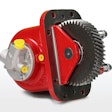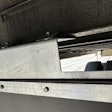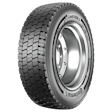While their function has barely changed in generations, the technology that goes into manufacturing shocks has evolved significantly.
Essentially, a shock absorber is only four pieces: a piston, a cylinder, a piston rod and a lubricant.
But while its engineering may seem simple, advancements have brought the components a long way.
Most manufacturers use split shock eye rings, but in the mid-90s, Gabriel launched a deviation from the standard: a solid steel eye ring.
“That provides reinforcement when the ring is welded to the rod,” says Gabriel Marketing and Communications Manager Christine Fisher. “With a split eye ring, any misalignment of the two sides of the split to the top of the rod will result in a weaker or reduced weld.”
Marketplace demands drive many component improvements. For instance,
Tim Bauer, director of Undercarriage Products at Meritor, says consumer feedback prompted his company to enter the shock absorber market this year with innovations of its own.
“It all came down to some of the fleet issues, and we wanted to solve those issues,” he says.
Among the most oft-referenced fleet concerns were excessive shock misting and leaking.
Misting is a normal and necessary function of a shock absorber, but excessive misting can lead to a rough ride, premature wear or be an indicator of other problems.
Misting occurs when the hot piston rod is drawn out of the shock body and the microscopic film of hot oil on the rod turns to vapor. This vapor, or mist, condenses when it reaches the cooler outside air and forms a film on the outside of the shock body.
Throughout this mechanical process, by design, the shock’s piston rod carries a film of oil through the rod seal to lubricate the seal lips. With one small alteration in this step, Bauer says, Meritor virtually eliminated excessive misting and leaking concerns.
“In our premium adjustable (shock), the hydraulic fluid has different viscosity,” he says. “As the fluid heats up, it doesn’t pass the seal lip.”
Fisher said Gabriel has also better calibrated seals and oils to enhance dampening performance up to 320 degrees.
“Extreme temperatures can break down standard shock absorber fluid, increasing friction and wear on internal parts,” she says. “To combat this, Gabriel introduced a unique formulation of (high temperature) fluid that maintains the ideal lubricating properties and enhances seal life.”
The seal itself, Fisher says, can also become a tool in combatting misting.
“(The seal) can be designed to wipe almost all the oil off the rod as the rod is extended from the shock.”
The challenge to this approach, she adds, is without a minimum quantity of oil allowed to cling to the rod passing by the seal, the seal will not be properly lubricated and will wear out, leading to a full blown leak.
“We have made several iterations in seal design over the past 10 years to continually improve the compromise between seal durability and misting – oil control lip design, materials and radial lip load between the seal and rod to make this an optimum system,” she says.
Bauer says Meritor has also implemented an advanced sealing system, partnered with premium hydraulic fluid and a robust design, to further control excessive misting and improve quality.
While the basic engineering of a shock itself is fairly simple, innovations are likely to continue as dictated by the market and demands of the fleets.
“We’re regularly in touch with our fleet customers,” Bauer says. “The feedback we receive from them – from both our products and our competitors – help us drive innovations and improvements in the marketplace.”











